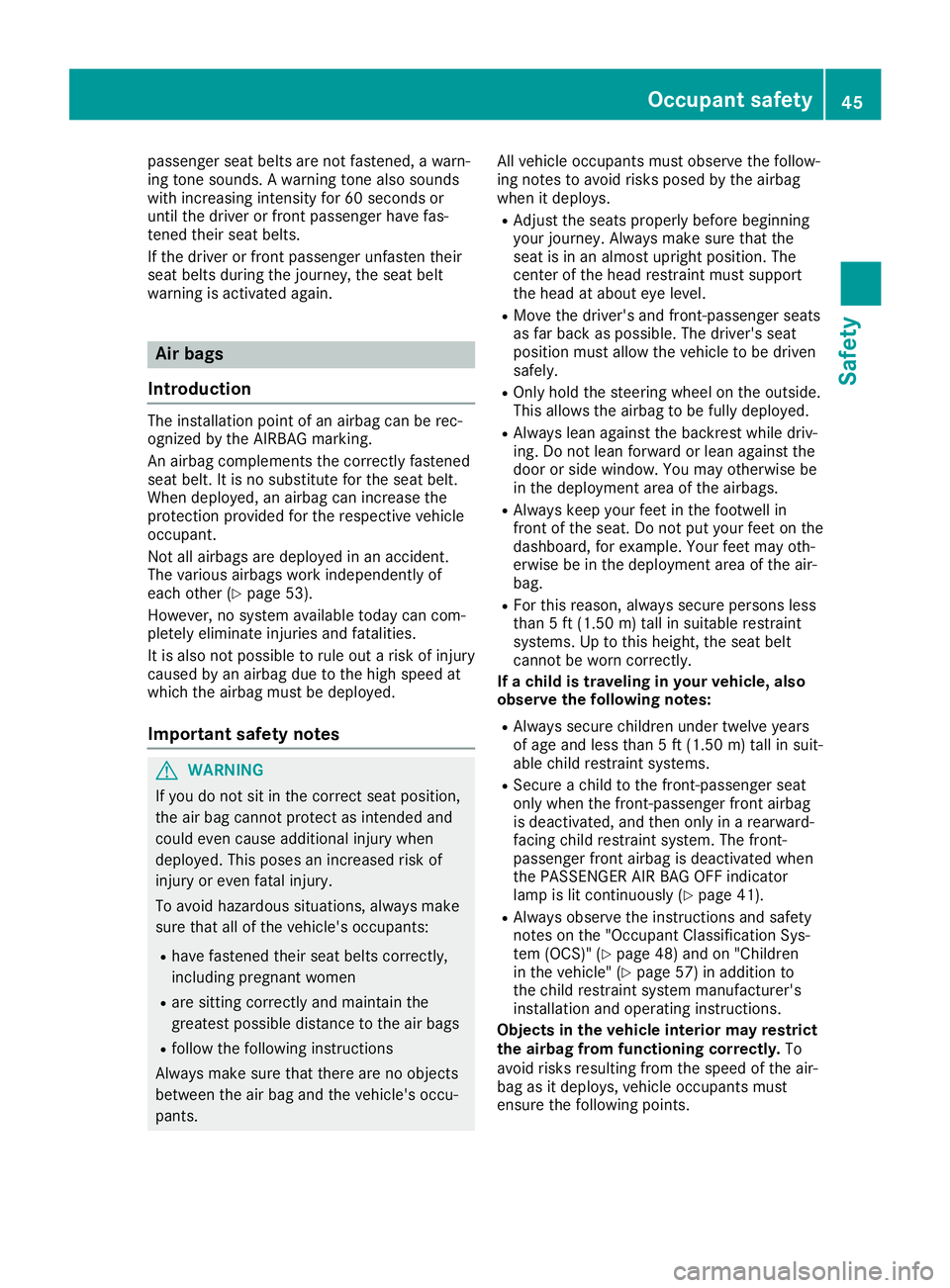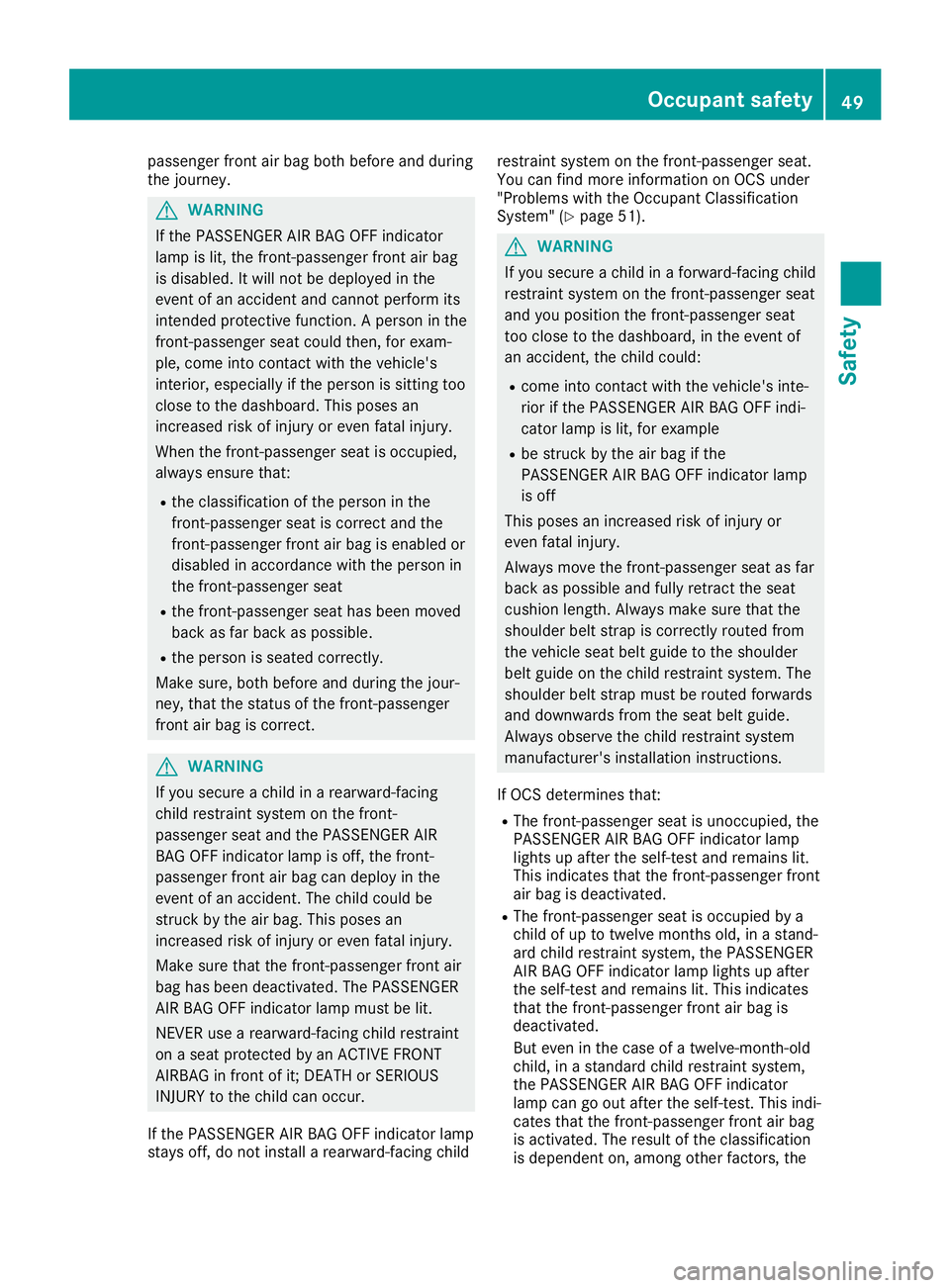2019 MERCEDES-BENZ SL ROADSTER dashboard
[x] Cancel search: dashboardPage 47 of 330

passenger
seatbelts arenot fasten ed,awarn-
ing tonesounds. Awarning tonealso sounds
with increasing intensit yfor 60secon dsor
until thedriver orfron tpassenger havefas-
ten edtheir seatbelts.
If the driver orfron tpassenger unfastentheir
seat belts during thejourn ey,the seat belt
warning isactiv ated again. Air
bags
Introd uction The
installation pointofan airbag canberec-
ogniz edbythe AIRB AGmarkin g.
An airbag complem entsthe corr ectlyfasten ed
seat belt. Itis no substit uteforthe seat belt.
When deployed, anairbag canincrease the
prote ction provided forthe respect ivevehicle
occ upant.
Not allairbags aredeployed inan acciden t.
The various airbags workindepen dentlyof
each other (Ypage 53).
However ,no system available todaycancom-
pletely eliminate injuries andfatalities .
It is also notpossible torule outarisk ofinjury
caused byan airbag duetothe high speed at
which theairbag mustbedeployed.
Impor tantsafet ynotes G
WARN
ING
If you donot sitinthe corr ectseat position ,
the airbag cann otprote ctas intended and
could evencause additional injury when
deployed. Thisposes anincr eased riskof
inj ury oreven fatalinjury.
To avoid hazardous situations,always make
sure thatallofthe vehicle's occupants:
R have fasten edtheir seatbelts correctly,
includin gpregnan twomen
R are sitting corr ectlyand maint ainthe
greatest possible distancetothe airbags
R follow thefollowing instruct ions
Always makesurethatthereare noobjec ts
between theairbag and thevehicle's occu-
pants . All
vehicle occupants mustobserve thefollow-
ing notestoavoid risksposed bythe airbag
when itdeploys.
R Adj ust the seats properly beforebeginning
your journ ey.Always makesurethatthe
seat isin an almost upright position .The
cen terofthe head restraint must support
the head atabout eyelevel.
R Move thedriver' sand front-passenger seats
as far back aspossible. Thedriver' sseat
position mustallow thevehicle tobe driven
safely.
R Only holdthesteer ingwheel onthe outside.
This allows theairbag tobe fully deployed.
R Always leanagainst thebackr estwhile driv-
ing. Donot lean forward orlean against the
door orside window. Youmay other wisebe
in the deployment areaofthe airbags.
R Always keepyourfeetinthe foot well in
fron tof the seat. Donot putyour feetonthe
dashboard, forexample. Yourfeetmay oth-
erwise beinthe deployment areaofthe air-
bag.
R For this reason, alwayssecurepersonsless
than 5ft (1.5 0m) tall insuitable restraint
systems .Up tothis height, theseat belt
cann otbe worn correctly.
If achild istraveling inyour vehicle, also
observe thefollowing notes:
R Always securechildren undertwelve years
of age and less than 5ft (1.5 0m) tall insuit-
able child restraint systems .
R Secur eachild tothe fron t-passenger seat
only when thefron t-passenger frontairbag
is deactiv ated,andthen onlyinarearward-
facin gchild restraint system. Thefront-
passenger frontairbag isdeactiv atedwhen
the PAS SENGER AIRBAGOFF indicat or
lamp islit con tinuously (Ypage 41).
R Always observe theinstruct ions andsafety
not eson the "Occupant Classification Sys-
tem (OCS)" (Ypage 48)and on"Children
in the vehicle" (Ypage 57)inaddition to
the child restraint system manufact urer's
inst allation andoperatin ginst ruct ions.
Objects inthe vehicle interior mayrestrict
the airba gfrom functioning correctly.To
avoid risksresultin gfrom thespeed ofthe air-
bag asitdeploys, vehicleoccupants must
ensure thefollowing points. Occupant
safety
45Safet y Z
Page 51 of 330

passenger
frontair bag both before andduring
the journ ey. G
WARN
ING
If the PAS SENGER AIRBAGOFF indicat or
lamp islit, the fron t-passenger frontair bag
is disabled. Itwill notbedeployed inthe
event ofan acciden tand cann otperfor mits
int ended protective func tion.A person inthe
fron t-passenger seatcould then,for exam-
ple, come intocon tact with thevehicle's
int erior, especially ifthe person issitt ing too
close tothe dashboard. Thisposes an
incr eased riskofinjury oreven fatalinjury.
When thefron t-passenger seatisocc upied,
always ensure that:
R the classific ationofthe person inthe
fron t-passenger seatiscorr ectand the
fron t-passenger frontair bag isenabled or
disabled inaccor dance withtheperson in
the fron t-passenger seat
R the fron t-passenger seathasbeen moved
back asfar back aspossible.
R the person isseated correctly.
Make sure,bothbefore andduring thejour-
ney, thatthestatusofthe fron t-passenger
fron tair bag iscorr ect. G
WARN
ING
If you secure achild inarearward-f acing
child restraint system onthe fron t-
passenger seatandthePAS SENGER AIR
BA GOFF indicat orlamp isoff, thefron t-
passenger frontair bag candeploy inthe
event ofan acciden t.The child could be
str uck bythe airbag. Thisposes an
incr eased riskofinjury oreven fatalinjury.
Make surethatthefron t-passenger frontair
bag hasbeen deactiv ated.ThePASSENGER
AIR BAGOFF indicat orlamp must belit.
NEV ERuse arearward-f acingchildrestraint
on aseat prote cted byan ACTIVE FRONT
AIRB AGinfron tof it;DE ATH orSERIOUS
INJURY tothe child canoccur.
If the PAS SENGER AIRBAGOFF indicat orlamp
stays off,donot installarearward-f acingchild rest
raint system onthe fron t-passenger seat.
You canfind more information onOCS under
"Problems withtheOcc upant Classification
System "(Y page 51). G
WARN
ING
If you secure achild inaforward- facingchild
rest raint system onthe fron t-passenger seat
and youposition thefron t-passenger seat
too close tothe dashboard, inthe event of
an acciden t,the child could:
R come intocon tact with thevehicle's inte-
rior ifthe PAS SENGER AIRBAGOFF indi-
cator lampislit, for example
R be struck bythe airbag ifthe
PAS SENGER AIRBAGOFF indicat orlamp
is off
This poses anincr eased riskofinjury or
even fatalinjury.
Always movethefron t-passenger seatasfar
back aspossible andfully retract the seat
cushion length.Always makesurethatthe
shoulder beltstrap iscorr ectlyrouted from
the vehicle seatbeltguide tothe shoulder
belt guide onthe child restraint system. The
shoulder beltstrap must berouted forwards
and downwards fromtheseat beltguide.
Always observe thechild restraint system
manufact urer'sinstallation instruct ions.
If OCS determ inesthat:
R The front-passenger seatisunocc upied, the
PAS SENGER AIRBAGOFF indicat orlamp
lights upafter theself-t estand remains lit.
This indicat esthat thefron t-passenger front
air bag isdeactiv ated.
R The front-passenger seatisocc upied bya
child ofup totwelve monthsold, inastan d-
ard child restraint system, thePAS SENGER
AIR BAGOFF indicat orlamp lights upafter
the self-t estand remains lit.This indicat es
that thefron t-passenger frontair bag is
deactiv ated.
But even inthe case ofatwelve- month-old
child, inastan dard child restraint system,
the PAS SENGER AIRBAGOFF indicat or
lamp cangoout after theself-t est.This indi-
cates thatthefron t-passenger frontair bag
is activ ated. Theresult ofthe classific ation
is dependen ton, among otherfactors, the Occupant
safety
49Safet y Z